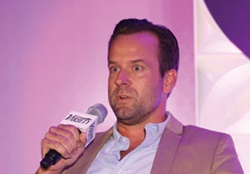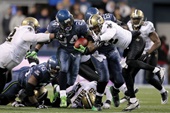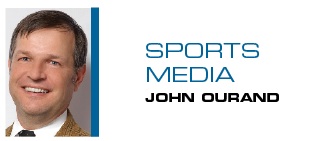Facebook is serious about its video strategy, and big media and top sports leagues have taken notice.
The social media company is not about to plunk down massive rights fees for live sports just yet. Its executives say they don’t plan to even kick the tires to get the rights to the NFL’s over-the-top game next season.
But the huge numbers Facebook is delivering on its video strategy already is about to make a big ripple in sports media. Last month, the company said that it’s generating 3 billion video views per day, triple the number from August when it was at 1 billion video views per day.
 |
“The thing that surprised me the most is how quickly the scale has gotten the attention of my entire company.”
Pete Vlastelica
Fox Sports
Photo by: GETTY IMAGES
|
“The thing that surprised me the most is how quickly the scale has gotten the attention of my entire company,” said
Pete Vlastelica, executive vice president of digital for
Fox Sports. “That’s significant considering where I work. We’re a broadcast media company, a traditional media company. And the numbers that we were able to present to my bosses are impressive enough that there are serious conversations about making a significant investment in programming for the Facebook platform and, generally, beginning to set aside production and programming budgets for emerging platforms.”
Vlastelica was speaking at a daylong Sports Summit event that Facebook organized in New York the week before the NBA All-Star Game. The event had panel sessions throughout the day and was designed to attract sports clients and give Facebook executives a chance to outline the company’s sports goals.
'We've come full circle to silent films'
The first video the NFL posted as part of its Facebook deal signed last year was on Dec. 23. It showed side-by-side touchdown runs from Seahawks running back Marshawn Lynch, one from a 2011 wild-card game against the Saints and one from Week 16 of the 2014 season against the Cardinals.
 |
The NFL used Marshawn Lynch’s 2011 ‘beastquake’ run in a Facebook video.
Photo by: GETTY IMAGES
|
The video is 33 seconds long and ends with a 10-second Verizon ad. At deadline, it had logged 4.9 million views, 115,550 likes and 51,684 shares. The NFL’s caption says: “Watch them side-by-side and tell us which was the BIGGER BEASTQUAKE!”
“Those that function well without audio and can still tell the narrative that we want to tell will be pretty impactful,” said Vishal Shah, the NFL’s vice president of media strategy and development.
Content owners have found that YouTube videos don’t work on Facebook. Neither do videos that require sound, as Facebook videos auto-start without sound.
“We’ve come full circle to silent films,” joked Pete Vlastelica, Fox Sports’ executive vice president of digital. “One of the things we’ve learned is that programming for Facebook is entirely different than programming for any other platform.”
Like the Lynch video, Fox Sports has found that shorter videos with bold graphics have been the most popular. They also opt for clips that users are most likely to share.
“What you get with Facebook is non-search-based discovery,” Shah said. “You’re absolutely going to get search behavior. But for those who are not necessarily searching on a proactive fashion, Facebook has a pretty strong technology.”
Julie Kikla, who is head of content partnerships for Whistle Sports, said a Facebook video strategy should be separate from a company’s YouTube strategy and a company’s Twitter strategy.
“As we’ve tested and used data to drive results, we’ve seen that it doesn’t cannibalize our YouTube audience,” she said. “That’s been a really important message to our YouTube stars for now. They’re not YouTube stars. They’re content stars.”
Three seconds and you're watching
■ How long do you have to watch a Facebook video before it is registered as a view?
PAKES: “We currently register you after three seconds. That’s based on two things: That’s the standard that comScore set for video views, and we decided to follow. The other is that we look at that as relatively consistent with the way that people use the News Feed. If people stick around longer than three seconds, they’re engaging with your content and not randomly scrolling by. We found that to be a relatively good measure of whether someone is spending time with your content.”
Reaching out to the teams
Facebook has developed relationships with most major sports leagues. Now, it plans to reach out to individual teams and wants to hire an executive to take on that role.
“Historically, we haven’t had a distinct vertical just focused on teams; we haven’t had a depth of relationships and best practices for teams,” said Dan Reed, Facebook’s head of global sports partnerships. “We want to change that. We’re looking for a head of teams now. There’s a real opportunity around the venues.”
Facebook is experimenting with some teams based on people who post status updates, photos and videos from games.
“Right now it’s purely organic,” Reed said. “But we know that check-ins are some of the most powerful engagement points for people when they actually come to an arena. Posting tends to go up on average when you’re in an arena.”
While numbers around Facebook video so far have been impressive, Vlastelica said Fox still hasn’t figured out how to make money from its Facebook videos, something that he said needs to change quickly.
“There’s some good ad products available, but not yet great ad products available,” he said. “When we’re comparing investments that we’ve done on television and our owned-and-operated digital platforms, we need to find a way to lead to our return on investment.”
Facebook still won’t announce a monetization strategy around video, though Matt Pakes, video product manager for Facebook, hinted that the social media site is working toward such a model. He drew a comparison to Facebook’s News Feed, which went through six years of tinkering from 2006 to 2012.
“I’m not saying that it’s going to take us six years to develop monetization for video,” he said. “My point is that we have a history and a track record of deeply caring about the user experience and building something that you want to come to every single day and spend a lot of time with. We think we can do the same thing in the video space. We’re just taking our time to get it right.”
Facebook signed a deal with the NFL in the fall that saw the social media company sell ads around game highlights and video clips — something Facebook executives still call an experiment. The league was Facebook’s first partner to go live with a video monetization plan. Over the course of six weeks, the NFL reached more than 60 million people with about 36 video clips, said Vishal Shah, the NFL’s vice president of media strategy and development.
“On the monetization front, I was very pleased,” Shah said. “There’s going to be an education for both the advertisers and the agencies. What is the value proposition to them? … There’s going to be an evolution of the ad product. I’m pretty convinced the monetization will be pretty successful because of the consumption.”
It’s not just videos that are drawing in big numbers. Facebook launched “The Hub” around the World Cup and Super Bowl — an area that aggregates status updates, photos and videos around specific big events. It reported that 65 million unique people were part of Super Bowl conversations on the social media site during the game and 350 million unique people were part of World Cup conversations during the monthlong tournament last year.
“This is a product that we want to continue to evolve,” said Dan Reed, Facebook’s head of global sports partnerships. “The ultimate goal is to create a real-time experience on Facebook for every sporting event that happens globally.”
“If you think about the potential for funneling hundreds of millions of sports fans into this customized experience for an event, think about the reach and engagement and distribution you can get from publishing in that hub.”
John Ourand can be reached at jourand@sportsbusinessjournal.com. Follow him at www.Facebook.com/JohnOurand and on Twitter @Ourand_SBJ.







